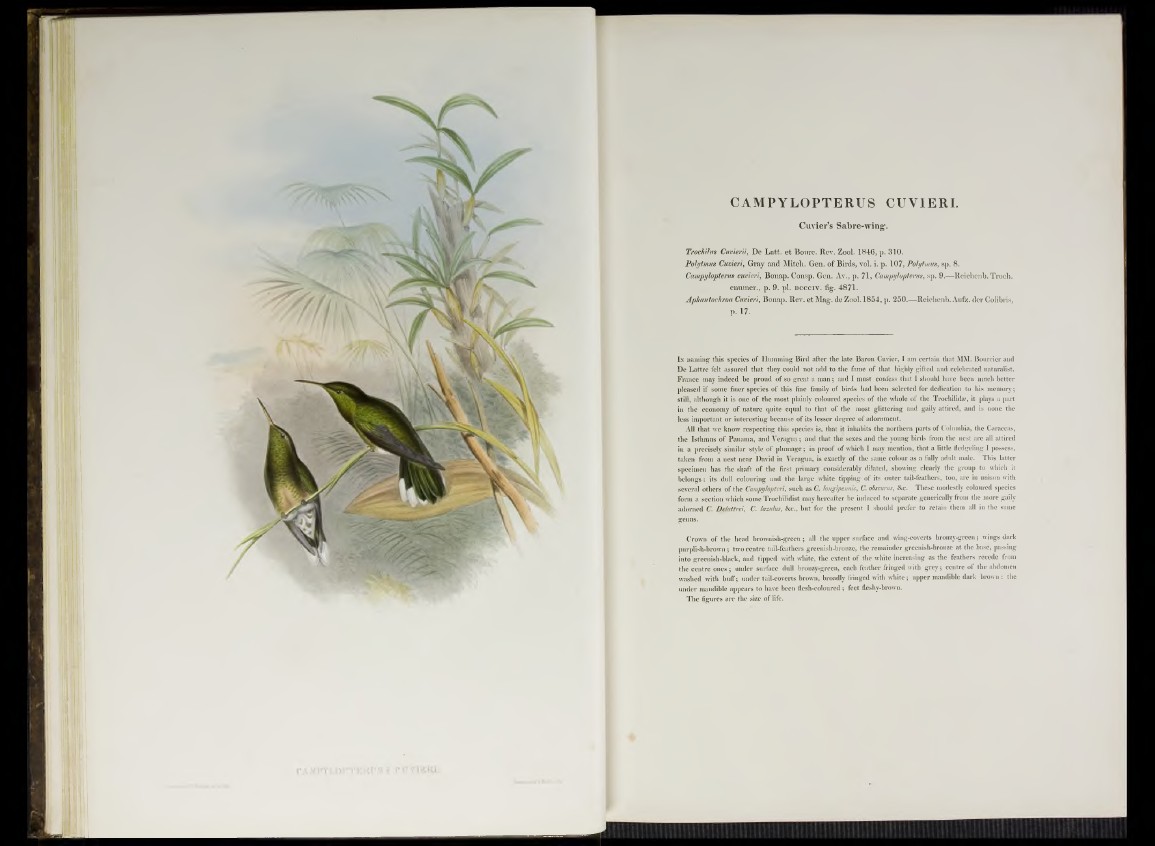
CAMPYLOPTERUS CUVIERI.
Cuvier’s Sabre-wing.
Trochïlus Cuvierii, De Latt. et Bourc. Rev. Zool. 1846, p. 310.
Polytmus Cuvieri, Gray and Mitcli. Gen. of Birds, vol. i. p. 107, Polytmus, sp. 8.
Campylopterus cuvieri, Bonap. Consp. Gen. Av., p. 71, Campylopterus, sp. 9.— Reiclienb. Trocli.
enumer., p. 9. pl. d c c c iv . fig. 4871.
Aphantochroa Cuvieri, Bonap. Rev. et Mag. de Zool. 1854, p. 250.—Reichenb. Aufz. der Colibris,
p .17.
In naming this species of Humming Bird after the late Baron Cuvier, I am certain that MM. Bourcier and
De Lattre feit assured that they could not add to the fame of that higlily gifted and celebrated naturalist.
France may indeed be proud of so great a man; and I must confess that I should have been much hetter
pleased if some finer species of this fine family of birds had been selected for dedication to his memory;
still, although it is one of the most plainly coloured species of thé whole of the Trochilid», it plays a part
in the economy of nature quite equal to that of the most glittering and gaily attired, and is none the
less important or interesting because of its lesser degree of adornment.
All that we know respecting this species is, that it inhabits the northern parts of Columbia, the Caraccas,
the Isthmus of Panama, and Veragua; and that the sexes and the young birds from the nest are all attired
in a precisely similar style of plumage; in proof of which I may mention, that a little fledgeling I possess,
taken from a nest near David in Veragua, is exactly of the same colour as a fully adult male. This latter
specimen has the shaft of the first primary considerably dilated, showing clearly the group to which it
belongs: its dull colouring and the large white tipping of its outer tail-feathers, too, are in unison with
several others of the Campylopteri, such as C. longipenuis, C. obscurus, &c. These modestly coloured species
form a section which some Trochilidist may hereafter be induced to separate generically from the more gaily
adorned C. Delattrei, C. lazulus, &c., but for the present I should prefer to retain them all in the same
genus.
Crown of the head brownish-green; all the upper surface and wing-coverts bronzy-green; wings dark
purplish-brown; two centre tail-feathers greenish-bronze, the remainder greenish-bronze at the basé, passing
into greenisli-black, and tipped with white, the extent of the white increasing as the feathers recede from
the centre ones ; under surface dull bronzy-green, eaeh feather fringed with grey; centre of the abdomen
waslied with buff; under tail-coverts brown, broadly fringed with white; upper mandible dark brown : the
under mandible appears to have been flesh-coloured ; feet fleshy-brown.
The figures are the size of life.